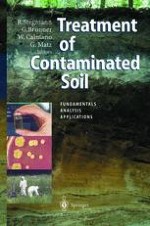2001 | OriginalPaper | Chapter
Electroreduction
Authors : J. Voss, M. Altrogge, D. Golinske, O. Kranz, D. Nünnecke, D. Petersen, E. Waller
Published in: Treatment of Contaminated Soil
Publisher: Springer Berlin Heidelberg
Included in: Professional Book Archive
Activate our intelligent search to find suitable subject content or patents.
Select sections of text to find matching patents with Artificial Intelligence. powered by
Select sections of text to find additional relevant content using AI-assisted search. powered by
Electrolysis was carried out at 40°C in a batch cell with a volume of 2×100 ml. The cathodic and anodic compartment were each filled with 100 ml methanol containing 0.1 M tetraethylammonium bromide as the supporting electrolyte. After the addition of 106 mg (0.26 mmol) of octachloronaphthalene (Jakobsson et al. 1992) and 100 mg (0.35 mmol) of the mediator 2 (Uchino et al. 1975) to the catholyte, nitrogen was bubbled through the solution to avoid any oxidation of the reduced mediator by oxygen. In order to achieve sufficient turn-over rates the potential was adjusted to −1.40 V vs. Ag/AgBr. The progress of the electrolysis was monitored by GC. For work-up the catholyte was poured into 100 ml water, acidified with half conc. hydrochloric acid and extracted twice with 150 ml hexane each time. The organic layers were dried with magnesium sulfate. The contents of naphthalene derivatives were determined per GC. The solvent was evaporated in vacuo and the products were weighed and analysed by GC. After the passage of 11700 A s at a current of 50-900 mA, a total chemical yield of 91% (current efficiency 3%) was obtained, which consisted of 86% naphthalene, 10% 2,2’-binaphthyl, 3% 1,2′-binaphthyl and < 1% 1,1′-binaphthyl (Nünnecke 2000).
